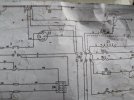Apologies in advance as this question is pretty basic, and it does show the limits of my understanding.
ref picture of wiring diagram:
Item 23 is ignition
Item 2 is solenoid
Item 1 is starter
Item 31 is alternator
Item 33 is coil
Item 28 is fuse box
So, I understand, when the engine is off, I turn ignition switch, it sends current to solenoid which kicks off starter motor. Ignition switch also sends current to coil, so we have sparks, and the engine runs. Harrah.
Now, if I turn off ignition, obviously no current goes from the ignition to the coil.
BUT you can see the NY, NY, W cable that leads from alternator (31) to pin 6 on the fuse box (28) (so when the engine is running, it powers up various items such as oil warning light etc).
If I turn off ignition, won’t there still be a bit of current flowing from the alternator, which then goes to the coil, so there are sparks, and the engine continues running etc i.e. it doesn’t stop.
Now, I know that doesn’t happen. But why not?
ref picture of wiring diagram:
Item 23 is ignition
Item 2 is solenoid
Item 1 is starter
Item 31 is alternator
Item 33 is coil
Item 28 is fuse box
So, I understand, when the engine is off, I turn ignition switch, it sends current to solenoid which kicks off starter motor. Ignition switch also sends current to coil, so we have sparks, and the engine runs. Harrah.
Now, if I turn off ignition, obviously no current goes from the ignition to the coil.
BUT you can see the NY, NY, W cable that leads from alternator (31) to pin 6 on the fuse box (28) (so when the engine is running, it powers up various items such as oil warning light etc).
If I turn off ignition, won’t there still be a bit of current flowing from the alternator, which then goes to the coil, so there are sparks, and the engine continues running etc i.e. it doesn’t stop.
Now, I know that doesn’t happen. But why not?

